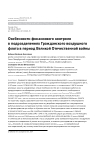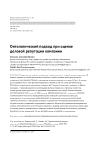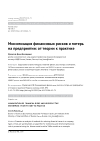Peculiarities of financial control in Civil air fleet units during the Great Patriotic War
DOI: 10.33917/mic-4.117.2024.83-90
The publication provides a list of features of financial control over the expenditure of funds from the salary fund in the divisions of the Civil Air Fleet, which include: ensuring the rational and timely expenditure of funds sent to the families of the dead or missing employees; prevention of non-compliance with the deadlines for operational accounting and reporting; the need to improve the process of operational accounting; personal responsibility of commissioners of special units for the preparation and passage of documentation; accurate accounting of all personnel: strict staffing; rational spending of funds for training personnel, maintenance of full-time personnel of educational institutions and stimulation of the activities of linear instructors-pilots; development of measures to stimulate the work of freelance pilot instructors; a full description of the purpose of expenses and sources of their financing during the selection and training of pilots. There are also savings in the process of training pilots in educational institutions and training squadrons during the Great Patriotic War of 1941–1945. Thus, cost savings were achieved due to a smaller number of full-time personnel, compaction of the working day, incomplete payment of annual bonuses and compensations for unused vacation, reduced duration of cadets in squadrons and early completion of training of some cadets, economical spending on the material part. The basis for improving financial control is timely or operational accounting, therefore, measures for its implementation were also considered.
References:
1. Lipin A.V. Navigational civil aviation service from takeoff to landing. Publishing House St. Petersburg State University of Civil Aviation named after Chief Marshal of Aviation A.A. Novikova, 2016. 153 p.
2.NPP GA USSR and NSD GA USSR//History and Information Portal of the International Public Movement «Air Navigation without Borders». URL: https://ovdrf.ru/page/744
3. Stalin I.V. Writings. T. 18. Tver: Soyuz Information and Publishing Center, 2006.













